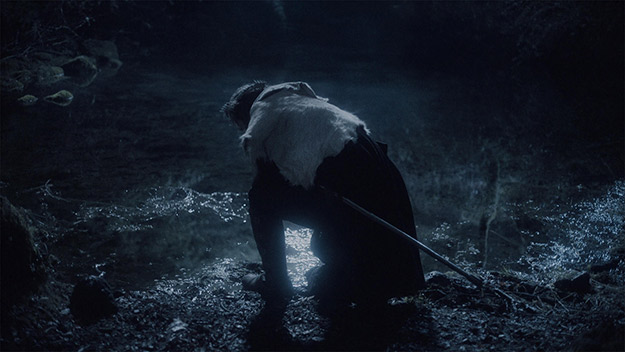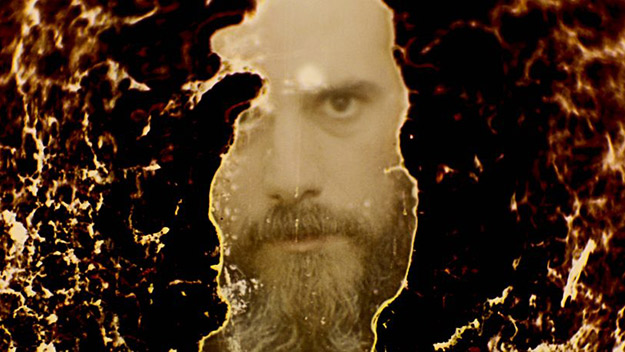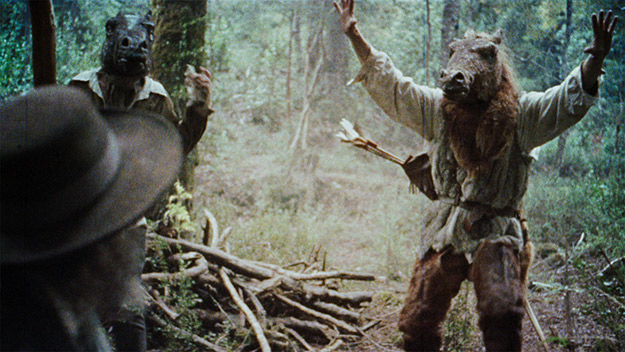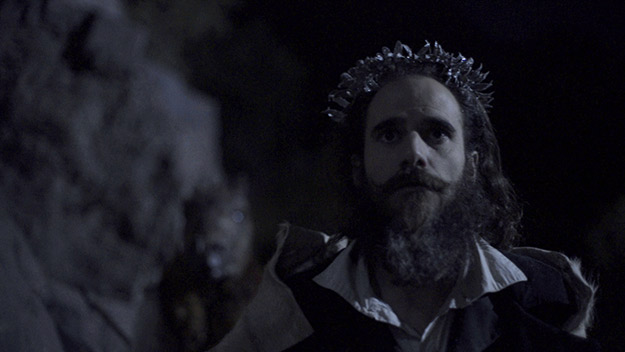Film of the Week: Rey

There surely exists some master algorithm that allows one to predict how marginally a given film will connect with an audience. In theory, the more money is invested in a film, the greater the number of people working on it and the more impersonal it is as a commercial production, then the more it’s likely to be absolutely central to the international map of cinema—at least, until it’s fallen off the box-office charts. Conversely, if a film is peculiar to one creator’s vision, made with devotion by a small team, or indeed handcrafted on minimal resources by a single intensely committed person, then it’s probably fated to exist somewhere on the far-flung edges of the cinematic wilderness, loved—possibly with absolute passion—only by a few.
This is no doubt stating the obvious, but it explains the heroism of such exotic blooms as American-Chilean director Niles Atallah’s Rey and the film I reviewed here last week, Bertrand Mandico’s Wild Boys. Both represent visionary strains of artisanal cinema at its most esoteric, each inhabiting its own aesthetic and imaginative micro-climate, which you can’t imagine being very hospitable to a large audience or to widespread discussion. Each does, it’s true, connect with a political sphere of interest that might give it a wider claim on public attention: Mandico’s film with its queer/trans themes and aesthetic, Atallah’s in its treatment of colonial history. Yet each film states its case in a manner so intensely personal that the idea of either of them existing in a wide public arena barely makes sense: these are films that insist you learn their language, approach them on their terms.
Rey—screening March 3 in the Film Society of Lincoln Center’s series Neighboring Scenes: New Latin American Cinema—is about as strange and as handcrafted as a piece of cinema can be while remaining ostensibly a coherent reality-based narrative. In one sense, it’s a historical biopic, of a somewhat apocryphal sort, telling the story of the bearded and cloaked gentleman shown at the start of the film in, presumably, an authentic 19th-century photograph. Atallah’s film tells the story of a man named Orélie-Antoine de Tounens, a French lawyer who arrived in Chile in the 1850s, travelled south to Wallmapu—the lands of the Mapuche nation, which Chile and Argentina had never managed to conquer—and conceived a plan to create a kingdom, eventually declaring himself King of Araucanía and Patagonia. Not surprisingly, he died unknown back in France, his story obscured by time, barely recorded in the footnotes of history.

Atallah uses several devices to recount this bizarre saga. One is simple dramatization, following the adventurer, played by Rodrigo Lisboa, on his journey through Mapuche territory, where he plans to make contact with a chieftain named Mañil. Told in chapters, the film narrates the story from de Tounens’s point of view, but also recounts some of the same events from the perspective of Rosales (Claudio Riveros), the guide who ends up betraying him to the Chilean authorities.
Another method of Atallah’s stands in contrast to the film’s elements of realism: you might call it Brechtian. De Tounens’s failed odyssey is framed by the dramatization of his imprisonment and trial by Chilean authorities, the anti-realism denoted by such elements as the fact that one of the hero’s captors seems to be wearing a distinctly 20th-century trenchcoat, the sort that might have been de rigueur in Augusto Pinochet’s army. You could easily miss this detail, however, because everyone in these scenes—de Tounens, the guards, the judge—is wearing a roughly executed mask, apparently of papier mâché. The locations for these sequences are no more naturalistic: the courtroom itself seems to be located variously in a forest clearing, or in a dungeon filled with dead leaves, while de Tounens is seen languishing in a deep, dark oubliette with light streaming from far above.
Atallah also cuts in much sampled archive material: images from early cinema that offer documentary illustrations of the story, such as South American landscapes, assorted flora and fauna, war episodes, or, in one hallucinatory image, nymphs dancing around a deer. But Rey’s most startling and elaborate effect is in the texturing. Shooting on 8mm and 16mm stock, Atallah and DP Benjamín Echazarreta have variously processed their material, in some points weathered and distressed it—apparently through methods such as burying it in the ground—so that the narrative is constantly disrupted by effects which bring Rey at once close to materialist film and to a sort of psychedelic image-jamming.

Rey is remarkably beautiful, not least when it’s consumed by the chemical transformations of celluloid, in a way that most recalls Bill Morrison’s Decasia. That film was an assemblage of images already ravaged by time, and Atallah artificially reproduces that form of damage (or enhancement) to ravishing effect. Images stutter and explode into storms of color, the soundtrack crackling along with the visual “snow” that fills the screen; sprocket holes momentarily appear, as the film seems to judder in the projector; clouds of mildew appear to devour the image. Other devices are familiar from the historical repertoire of experimental film: images are polarized, colors reversed; there are tintings, superimpositions, and something I can only describe as a “rushing water” light effect, for example when a shot of de Tounens is overlaid with a sheaf of flowing light and a distorted image of a young woman, possibly achieved, as far as I can figure it out, by projecting on glass. There are echoes of Méliès in Atallah’s technique, but of sixties experimentation as well: in some sequences, he has taken a sharp point to the celluloid, frame by frame, so that de Tounens’s eyes and mouth dance in animated scratchings.
Rey seems to use any technique whatsoever that comes into its makers’ heads: the film seems to have invented itself out of thin air, just as de Tounens invented himself. It doesn’t always pay off, especially in Rey’s more theatrical moments. One bizarre sequence has de Tounens encountering some sort of nature spirits depicted as huge white heads on legs, one of which emits clouds of steam into his face; they then join with him in a dance amid flames, a moment that has the awkward air of a late eighties “tribal rave” event. When a “tree oracle” addresses de Tounens in an electronically processed voice reminiscent of the Residents at their goofiest, you really feel that Atallah has overplayed his hand.
No apologies for the preceding inventory of effects: the film is so diffuse, so exuberantly unruly in its anything-goes fervor, that it’s hard to get a purchase on it as a unified object. In many ways, the film is most effective when it’s least embellished, and some of the sequences in which de Tounens’s journey is shot and presented more or less “raw” are among the most effective: a wild-eyed bearded figure, de Tounens is someone that Daniel Day Lewis or Joaquin Phoenix might play in a Hollywood version, but Rodrigo Lisboa is plenty charismatic, commanding attention at once as a would-be Jesus figure and presumptuous white redeemer (his crown of blue frosted petals standing in for thorns) and a belated failed conquistador.

The story Atallah tells is almost generic, connecting as it does with a swathe of movie legends about deluded self-appointed monarchs or colonial conquerors out of their depths in unfamiliar continents (Lisandro Alonso’s similarly hallucinatory Jauja, Lucrecia Martel’s Zama, the Herzog-Kinski cycle, Apocalypse Now). Rey is in some ways at its most magical when it’s done straightest, when Atallah allows a moment of drama to play out with the least visual trimming—like de Tounens’s meeting with a man of the hills who communicates in song and whistling before speaking the language of Mapundungun, then Spanish. “How is it that you speak Spanish?” de Tounens asks the man. “How is it that you speak Spanish?” the Mapuche asks the Frenchman.
Rey is a patchwork, dazzling and sometimes frustrating—as willfully hit-and-miss a venture as anything I’ve seen recently. At times there’s a rich, poetic seriousness (as in de Tounens’s opening monologue: “I am the son of water. I am the night bird… I am one hundred flies that move as one”). At times, the film successfully pulls off playful comedy, as with the two actors in horse masks who represent the adventurer’s mounts. Elsewhere, the tone can be whimsical or childlike in a way that never convinces: while I see what Atallah is doing with those masks, destabilizing that period in his hero’s life as any kind of baseline of reality, the strangeness of those scenes pales in relation to the rest. When a final caption reminds us that the struggles of Latin America’s indigenous peoples continue to this day, it’s almost as if the film had emerged from a reverie and awakened with the words, “No, but seriously…” You’re not entirely convinced that Atallah has been thinking that much about the indigenous peoples for the preceding 90 minutes, at least not with the focus he might have shown in a more conventional film. Still, Rey is a bold, freakish marvel, a bottle in the ocean of cinema, but worth cracking open—it contains not one message but a whole mass of them, scrawled in many different scripts and colors with artisanal passion and (sometimes) genuine inspiration.
Rey screens Saturday March 3 as part of the Film Society of Lincoln Center’s series Neighboring Scenes: New Latin American Cinema.
Jonathan Romney is a contributing editor to Film Comment and writes its Film of the Week column. He is a member of the London Film Critics Circle.







